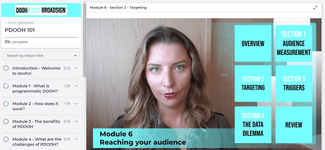The phasing out of third-party data has many marketers asking what the effects will be on digital advertising. The changes are already evident. Tech providers continue to prioritize privacy protections, and browsers like Firefox and Safari have moved away from the use of third-party cookies, with Google to follow in early 2023. It’s clear that this movement will forever change how consumers are targeted but it leaves many wondering what impact it will all have on the OOH industry?
Adam Green, Senior Vice-President of Strategy at Broadsign, addressed this topic during his presentation titled “As the cookie crumbles, will context take the cake?” at the recent Future. Proof. OOH Media Conference. We gathered up a few clips of his presentation to share his thoughts on changes in digital marketing today and how these can inform DOOH strategies down the line.
Are we being followed? Kind of.
Adam asked a question we’ve all surely wondered about: Have you ever felt like the Internet was watching you?
It can feel that way sometimes. It seems like just a casual mention of a random topic can trigger a targeted ad the next time you’re scrolling Facebook or Instagram. This tends to be a little unsettling and has led consumers to ponder what other information these companies might have about us, interests, and activity.
According to Adam, the notion that we’re being listened to is sometimes based on confirmation bias—but it’s also not entirely a product of our imaginations. He explained that by using unpaid apps or even browsing specific websites, whether you’re aware of it or not, you’re participating in a third-party data ecosystem that sucks up a bunch of information.
Change is imminent
Though ad-supported data has been widely accessible to advertisers in the past, a change of heart from big tech companies marks a step towards a less intrusive advertising experience, one focused on data protection and privacy. Such a move encourages a more regulated browsing experience and can ease the worries of users concerned with what information is already out there—and what’s being tracked, shared, and potentially exploited for advertisers’ gain. Here, Adam explains how this shift began and what this means for digital marketing moving forward:
Why should OOH companies care?
The two main reasons why those in the OOH industry should care about these changes to third-party cookies, the first of which is, understandably, money. Adam explained that the programmatic digital ad market is roughly seven times as large as DOOH as a whole, and of that, between one-fifth to a half of the market relies on third-party data, representing a significant amount of potential revenue.
He added that a second reason OOH companies should care is that not having third-party data will affect how they operate, given that many OOH providers rely on third-party data to structure media plans and build customer profiles. Ultimately, the end of third-party data means that the OOH industry will need to explore new, cost-effective ways to reach audiences.
Where it’s headed (and why that spells opportunity for OOH)
While the future of data collection remains uncertain, it’s not likely to be going anywhere anytime soon. Adam discussed all that consumers can expect in light of the third-party data phase-out, including that companies and brands may find other ways to deepen their ties by leveraging first-party data metrics like newsletter sign-ups or website opt-in forms. Another significant factor will see context playing an even greater role in the OOH space. By that, Adam explained that when planning content or campaigns, media owners and publishers will need to think about what specific scenarios and what context will help make inventories shine. He shared a few examples, citing that location, demographics, weather or traffic tracking, or live-data feeds will all be vital in guiding future DOOH campaigns. Adam breaks it down here:
The responsibilities of tech providers
Finally, Adam looked at the changes in the third-party data ecosystem and what opportunities await OOH companies. He expressed how, as tech providers, it’s in our hands to make the possibilities with DOOH scalable and accessible while ensuring tools that provide greater context, like real-time weather or data feeds, are made more readily available. Companies should also consider that it shouldn’t take months of data analysis to pull off effective campaigns—the process needs to be quick and efficient. In the end, what the OOH industry needs to do moving forward is rally together and seize the unprecedented opportunity to get a bigger slice of the pie in this post-third-party data ecosystem.
A big thank you to the OAAA and Geopath for hosting such an illuminating event and inviting Adam to speak.
Want to partner with us?





